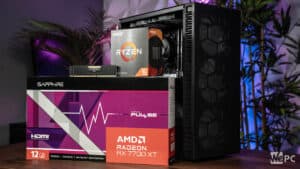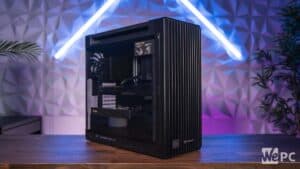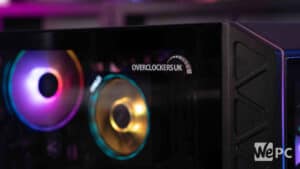Best computer for animation 2024 – our top animation PCs
We Pick Out The Best PCs & Macs For Animators Currently Available
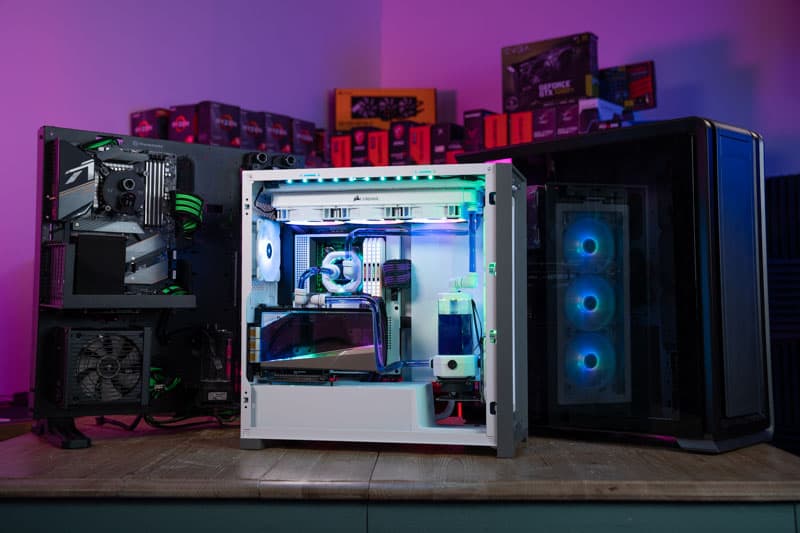
WePC is reader-supported. When you buy through links on our site, we may earn an affiliate commission. Prices subject to change. Learn more
The creativity of animators from all over the globe is what brings us some of the most entertaining, moving, and memorable movies and shows. There is no modern world without all kinds of animation, but do you have the best computer for animation? We have come a long way from the days of old, hand-drawn cartoons. These days, the majority of animation is done by skilled professionals with the help of the latest software, but none of that can take place without a very powerful machine to run it.
A computer suited for animation is going to rank high amongst the most powerful PCs. The reason for that is simple: you need a powerhouse capable of creating complex 2D and 3D animations, and then rendering at full power without slowing you down. This means that you’ll be looking for something with an amazing CPU, a lot of hard drive space, a considerable amount of RAM, and the best GPU.
We want to save you time and let you enjoy your new machine sooner. For that reason, we’ve tested several prebuilt desktops that offer everything you need in a PC for animation. Regardless of your budget or expectations, we’re confident that you’ll be able to find something to match your exact needs.
Today’s best gaming PC deals
- ASUS ROG G16CH (2023) Gaming Desktop PC – Save 7% NOW!
- Corsair Vengeance i7400 Series Gaming PC – Save $350 NOW!
- Thermaltake Reactor 380 Liquid-Cooled PC – Save 50% now!
- Skytech Prism II Gaming PC Desktop – Save 49% NOW!
- MSI Aegis R (Tower) Gaming Desktop (RTX 4060, i5-12400F) – Save $149 now
- ASUS ROG G16CH (2023) Gaming Desktop PC – Save $200 now!
- YEYIAN Yari X21 Gaming PC Computer – Save $300 NOW!
- ASUS ROG Strix G10 Gaming Desktop PC – Save $354 NOW!
- Alienware Aurora R16 Gaming Desktop – Save 15% NOW!
- Alienware Aurora R15 Gaming Desktop – Save 20% now!
Best computers for animation
Skytech Pro Eclipse Gaming PC
Skytech Pro Eclipse Gaming PC Desktop (RTX 4090)
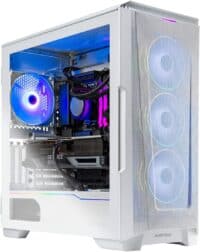
CPU
Intel Core i9 13900K
GPU
RTX 4090
RAM
32GB DDR5
Storage
1TB NVME
- High-end gaming performance
- Powerful gaming CPU
- Overall specs make this feel very snappy
- Well priced
- Only 1TB of storage
Our top selection of hardware is the Skytech Pro Eclipse. Featuring the top of the components, you really don’t lose out on much with this PC. It can certainly cut down any rendering times and provide great performance across the board. The Skytech Pro Eclipse provides all you might need and with a good design to go alongside it. As with a mesh front panel on the case, and liquid cooling you can ensure great performance across the board.
Featuring an RTX 4090 and i9 13900K, the prebuilt does not skimp out on any performance with some of the flagship choices to go for. They’re incredible parts that are the best you can get before the true enterprise hardware is the only thing above it. As such you will have the top PC for animation.
Alongside the core components, you also get good power and power from the RAM and storage. With 32GB of DDR5 memory and a 1TB NVMe SSD, it provides plenty of speed and capacity for you to enjoy and appreciate. It will easily load and store any of the files and apps you require especially key to keep you waiting a long time for animations to load and will keep it smooth for even the bigger files.
iBuyPower Pro Y60 Gaming PC

iBuyPower Pro Y60 Gaming PC (i9-13900KF, RTX 4070)

CPU
Intel Core i9-13900KF
GPU
RTX 4070 12GB
RAM
32 GB 5200 MHz DDR5
Storage
1TB NVMe SSD
- Top end CPU and GPU offer plenty of performance from the new generation
- Comes with 32GB of very fast RAM, which gives you a lot of potential for lots of tasks
- Built in a modern and nice looking case
- Only comes with one storage option with a limited capacity that will need expanding eventually
Now for something a bit more affordable, the iBuyPower Pro Y60 is the animation computer to go for. It still has a top-range CPU with the i9-13900KF, along with the more value option of the RTX 4070 for its graphics card. With top-choice processing, you can handle any workload across the board. The new GPU offers up new-gen hardware and features for a much better value than some of the others in the range from Nvidia.
It also offers up 32GB of DDR5 memory which is the latest generation with plenty of capacity and speed that comes with it. As such you don’t have to wait long for loading times and keep your CPU lined up with data. As for the storage, you also get a 1TB NVMe, which may be a bit limiting but it’s not hard to expand what you have if you need it.
The case used is also a great choice as we found in our Hyte Y60 review, providing great cooling capacity with the thought-out design and fans provided. Along with a liquid cooling solution for your CPU and a vertically installed GPU that brings something new to the lineup.
Skytech Shadow 3.0
Skytech Shadow 3.0 (R5 3600, RTX 3060 Ti)
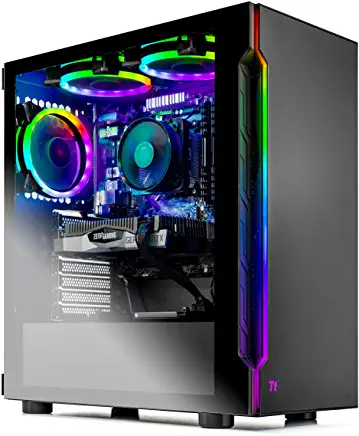
CPU
AMD Ryzen 5 3600
GPU
RTX 3060 Ti
RAM
16GB DDR4
Storage
1TB NVMe SSD
- Fast storage for booting and loading
- Solid front panel may limit airflow and performance
- Built on an old gen platform that is obsolete for upgrades
As for a more budget option, the ever-popular GPU inside the Skytech Shadow 3.0 is a great PC to go for. It does bring with it some older hardware that does have some upgradeability down the line but still offers a great value solution and one of the best PCs under $1,000.
The RTX 3060 Ti is one of the best value choices from the Ampere generation and provides a good range of performance, such as the fact it does well in benchmarks even at 1440p, and holds up well the its replacements. It also brings great efficiency and encoding performance for any 3D options you may be after. The CPU is a more budget option on the AM4 platform but provides great efficiency and performance with it. With plenty of options down the line, it still has plenty of opportunity to improve it.
The RAM is the older gen DDR4 and with 16GB of it, it still is plenty of fast and great for anything you might be interested in but it can be more limiting these days. As for the storage, you do get 1TB of NVMe SSD which allows you to appreciate fast responsiveness and loading and with plenty of starting capacity. Although the case also leaves some things to be desired, with a solid front panel the airflow can be limiting to the performance.
Things to consider
You already know that you want to buy a brand new PC for animation, and you’ve had a quick look at our favorite options. We will introduce them to you properly below, but before we do, we want to make sure you know exactly what type of PC you need.
Let’s take a look at some of the things to consider before making your choice.
What specs do I need for animation?
Whether you’re a budding animator on a quest for your first PC or a pro with years of experience under your belt, this is a question you probably ask yourself: what kind of specs does my future PC need to have?
It’s easy to be led to believe that you need the absolute best of everything, but that is not always the case. However, we freely admit that when it comes to animation, you need to be looking for a really strong computer. Below we will describe the most important components in a pre-built PC. But the likes of Autodesk Maya don’t need the top-spec hardware and ask for a minimum:
- CPU:
- 64-bit Intel® or AMD® with SSE4.2 instruction set
- For macOS, Apple Silicon arm64 or Intel x86
- Graphics, a certain range of hardware recommendations:
- GTX 680 and above, or R9 Fury
- RAM:
- 8GB+ (16 recommended)
- Storage:
- 7GB for install
Processor (CPU)
The processor is the most important part of any PC, be it a gaming computer or an animation powerhouse. During rendering, your CPU is going to be running at 100% for the entire time. On top of that, it needs to be fast in order to not slow you down as you’re working.
The type of CPU will depend on your budget. The latest builds include either an Intel i9 or an AMD Ryzen 9 processor. These CPUs can be overclocked to up to a showstopping 5 GHz. Of course, using this type of processor is not a necessity, but the general rule of thumb is the stronger the better.
Memory (RAM)
As your computer is going to be performing a lot of tasks at once, and all of them rather heavy-duty, we recommend picking a model that has a good amount of RAM. Nearly every modern PC has at least 8 GB, but it’s better to aim higher. For smooth performance and seamless rendering, you’ll want to look at 16 GB RAM at the minimum, with 24-32 being the recommended amount.
Graphics card (GPU)
A strong GPU is crucial in an animator’s desktop, especially if you are looking to do 3D animation. The right graphics card will allow your PC to perform tasks such as mapping, modeling, and animation in both 2D and 3D, and it will do so without any issues. While some pre-built PCs come with integrated graphic cards, all of our recommendations have dedicated GPUs. These are known to be way more powerful and capable of aiding your animation work.
Storage (SSD and HDD)
High-quality animation projects take up a whole lot of space on your hard drive, and this is why you will need quite a bit of storage. Especially if you’re a professional who does a lot of animation, you will find that the more the better is also true for your HDD or SSD space.
An SSD is almost a must these days, as it ensures that your most important programs, including your operating system, run seamlessly and at near-light speed. However, if you don’t want to invest in a massive 1 TB SSD, it’s okay to pick a model with a smaller SSD and a huge HDD.
What else do I need?
The PCs on our list all meet the above recommendations, but a desktop alone will not suffice. As an animator, you will also need to invest in a couple more things to set you off on the right foot.
If the thought of having to empty your wallet is scary, don’t worry. Cheaper options are absolutely possible and well within your reach! Before we discuss the various prices and how they fit within your budget, let’s take a look at what else you’ll need other than just your new beast of a PC.
- An animating tablet – this is something most animators use to create and bring their works to life. When it comes to tablets, you will find that there is a full range of options, starting from fairly cheap all the way to premium products. In general, it’s good to buy a tablet of a similar tier to your PC — you don’t want to go cheap if your PC is capable of doing so much more.
- Operating system – whether you’re a fan of Windows, Mac, or Linux, most animating software is adapted to all three. It’s best to go with what you’re comfortable with.
- Dual monitors – there is almost no way around this as an animator. You can splurge and invest in huge IPS screens, which are known for their true-to-life colors, or you can save and pick something else. However, you will most likely need two for efficient work.
What kind of budget do I need for a computer for animation?
No matter if you’re looking for a massive powerhouse or a good starting point, your budget will always play a role in your final decision. When it comes to pre-built PCs, the price difference between different models may be staggering and reach up to thousands of dollars.
If you’re a professional, it’s likely that this will not be your first desktop for animation. For those that perform heavy rendering, especially in 3D, the prices may seem a little steep. However, keep in mind that for every dollar you invest, you are receiving a range of features that stand out from the competition.
On the other hand, if you know you won’t need the absolute best specs on the market, you can still achieve fantastic results without paying for the latest builds.
To make things easier for you, we’ve prepared an approximate price range for different pre-built desktops for animation.
- Low-end PC for animation – $600-1000
- Low-end PC for 3D animation – $750-1200
- Mid-range PC for animation (2D and 3D) – $1200-1800
- High-end PC for animation (2D and 3D) – $2000+
It’s worth noting that some of the top models on the market can cost upwards of $4000. While this certainly is not cheap, don’t forget that you will get an incredible machine in return for your investment, and it will definitely last you years.
Final word
Navigating the jungle of prebuilt PCs is hard enough when you just need something to run MS Office, and this task is only made harder by adding animation into the mix.
Computers built for animation are true powerhouses that will not just help you with animating and rendering. They will run practically any game at the highest settings and suit most other uses one could possibly think of.
We hope that our article has helped you make your decision. Now that you know everything there is to know, all that remains is to make your final choice, and then, at long last, enjoy your brand-new PC.
What Computers Do Disney Animators Use?
As far as anyone knows, Disney has been using Hewlett-Packard Workstations since 2002, and just like Pixar, they rely heavily on Linux as an operating system.
Being that Disney bought Pixar in 2006, it wouldn’t surprise us if they had identical tech. What has been established is that Disney uses the Pixar-developed Presto animation software for the bulk of their productions.
Having decided against developing proprietary CPU and GPU technologies, the specifics of Disney computer builds are probably not all that dissimilar to our own standard high-end systems.
Is Intel or AMD Better for Animation?
Both Intel and AMD make awesome CPUs for animation. Their high-end models all feature a wealth of multithreaded (hyperthreaded in Intel tongue) cores, which is exactly what the doctor ordered for bringing your creations to life. Even though the top picks at the minute are largely Intel creations, if we had to pick just one champion of the animation world, it’d have to be AMD.
Whereas most Intel CPUs are fractionally faster for gaming due to their snappy single-core speeds, AMD chips tend to hold the premium on cores, making them the best for handling creative workflows.
It’s not just animation AMD CPUs excel at, but any sort of computational multitasking, so if you like to listen to music or hoard tabs while you work on your animations, they’re probably the way to go. That’s not to say that Intel CPUs aren’t capable of similar performance. It’s just that their best won’t be quite as efficient as AMD’s best for animation.
What Computers Do Pixar Animators Use?
Animators at Pixar use a variety of different computers to create their amazing movies. Which computer is preferred depends on the department. Employees that don’t work on 3D art and focus on preliminary aspects of the design process like concept art are likely to use high-powered Apple Macs.
Those heavily involved in the 3D art pipeline use Linux-based computers loaded with Pixar’s patented Presto animation software. Some of these Linux-operated computers at the core of Pixar’s animation process will also feature Windows software, so they have access to important Windows-only programs.
When the design work is complete and the time comes to render the final sequence, no one computer is responsible. They’ll use what is known as a render farm. These are full arrays of server-grade computers with the sole task of rendering.


